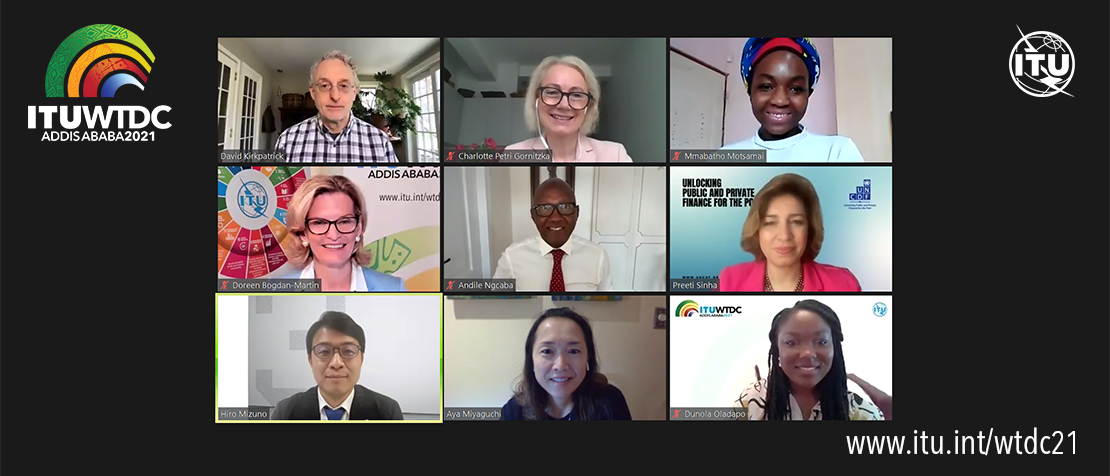
Finance2Connect: Finding ways to fund connectivity
What will it cost to connect the world and bridge the current digital divide? How and where can we find the money to fund the global digital transformation?
Financing connectivity is recognized as a key priority in the United Nations Secretary-General’s Roadmap for Digital Cooperation.
During a recent high-level debate on digital cooperation and connectivity, the President of the 75th Session of the United Nations General Assembly urged the global community to work creatively with public and private stakeholders to forge a new paradigm to drive digital development. Creative collaboration will be the key focus of the next World Telecommunication Development Conference (WTDC), a major International Telecommunication Union (ITU) forum set to bring together 193 governments with private sector investors, national, regional and international development finance institutions, academia, and civil society.
A wake-up call
During the virtual session Finance2Connect, Doreen Bogdan-Martin, Director of the ITU Telecommunication Development Bureau, said prioritizing connectivity was vital to protect nations from future crises, because it “confers resilience, protects economic performance, preserves social cohesion, and drives growth.” Fallout from COVID-19 have exacerbated long-standing development challenges. “For too many, the absence of digital access has intensified the socio-economic impact of the pandemic,” noted His Excellency Volkan Bozkir, President of the 75th Session of the United Nations General Assembly. “We must see this as a wake-up call and make every effort to close the digital gap now. With literally trillions of dollars pouring into global recovery efforts, we have the resources to expand digital access worldwide quickly and dramatically.”
Bozkir called for broad collaboration with ITU to come up with creative proposals, incentivize investment in connectivity, and to ensure funding is allocated to much-needed infrastructure.
Digital applications, if properly financed, can leapfrog other, more physical, infrastructure development, such as road construction, said Preeti Sinha, Executive Secretary of the UN Capital Development Fund. “Blended finance, along with market development, is the key,” she said. However, digital infrastructure will always remain interlinked with global sustainable development goals – especially as it relates to financial inequality. Failure to address current inequalities and create a global movement around the SDGs, will “have a detrimental effect on all investment funds,” warned Hiro Mizuno, UN Special Envoy on Innovative Finance and Sustainable Investments.
Tapping existing resources
Connecting the remaining 3 billion people aged above 10 to the Internet by 2030 requires investments of USD 428 billion, notes the ITU study Connecting Humanity. Subsequent ITU findings suggest that a 10 per cent increase in broadband boosts per capita GDP by 2 per cent or better.
The question is how to direct existing financial resources, as well as dividends from cryptocurrencies and other new investment types, to where they are needed most.
This is a tall order given gaping economic disparities worldwide. According to Organization for Economic Cooperation and Development (OECD) research, out of USD 379 trillion in global financial assets, 81 per cent are in high-income countries; 19 per cent in middle-income countries, and less than 1 per cent in low-income countries.
Universal ownership
To encourage higher investments in connectivity projects, UN Special Envoy on Innovative Finance and Sustainable Investments Mizuno argues for a universal ownership approach, providing aggregated investment opportunities together with development banks and UN entities.
Expanding the stakeholder base should also involve youth, suggested Mmabatho Motsamai from ITU’s Generation Connect Visionaries Board.
Although young people are often viewed as consumers, many in the Global South work in informal economies that remain untapped by financial institutions.
Crowdfunding connectivity
Andile Ngcaba, Founder of Convergence Partners, suggests open sourcing network infrastructure could cut total global connectivity costs by 25 per cent. Digital bonds and tokenized infrastructure could support inclusive financing mechanisms for local communities, while licence fees could be waived for the newly connected. “In my village, in my township, I can have a piece of ownership,” Ngcaba explained.
“We can almost crowdsource that USD 428 billion.”
Blockchain technology can “provide a trust network between investors, public agencies, and individuals,” added Aya Miyaguchi, Executive Director of the Ethereum Foundation.
A mindset shift
Beyond profitability, investing in connectivity brings social benefits. But project partners need to know the social outcomes of their infrastructure investments, said Charlotte Petri Gornitzka, Assistant Secretary-General and Deputy Executive Director for Partnerships at the United Nations Children’s Fund (UNICEF). Giga, a UNICEF-ITU initiative to connect every school and community to the Internet by 2030, maps and measures progress with real-time data.
Next stop on the Road to Addis
Preparations are underway for WTDC-21, planned to be hosted in Addis Ababa, Ethiopia, partnerships, inclusion, leadership, innovation, and youth – along with financing – as enablers of connectivity for sustainable development. The “Road to Addis” series continues on 22 June, with a focus on leadership, and culminates in September with outcomes presented at the United Nations General Assembly.
To engage with ITU and contribute to the impact of WTDC, contact us here.
Watch the full Road to Addis: Finance2Connect session here. Learn about ITU’s Financial Inclusion Global Initiative (FIGI) Symposium, which is taking place from 18 May to 24 June 2021.
